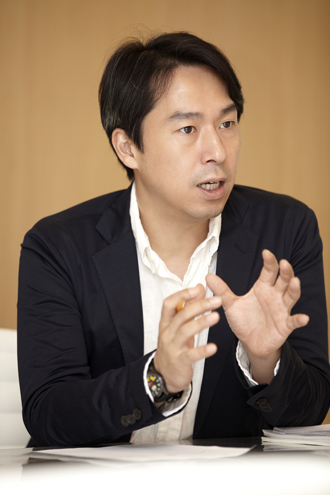CEO Kim Young-min talks past, future

Kim Young-min
But how did this come to be and who is managing these gifted entertainers?
In the Korean music industry, the talent runs deep - talent scouts, managers and marketers have all played vital roles in the rise of the Korean Wave.
According to the Ministry of Culture, Sports and Tourism, there are some 500 agencies registered in Korea, although the actual number is expected to be nearly double that. And some financial analysts say business prospects look quite rosy as the appeal of K-pop grows in the world’s largest and fastest-growing markets. Doors are already opening to other sectors like tourism and retail.
This is the first installment of a new Korea JoongAng Daily series that dives into Korea’s entertainment companies and explores how they differ from one another, from their range of K-pop talents to their overseas marketing campaigns.
Kim Young-min joined SM Entertainment in 1999 as the director of the company’s overseas business division.
The 42-year-old lived in Japan for 16 years during his elementary, middle and high school years and has worked as an interpreter. Kim was put in charge of BoA’s Japan debut in 2001.
Since 2005, Kim has been the chief executive of SM. The Korea JoongAng Daily talked with the young CEO via e-mail to discuss his experience with the Hallyu over the past 13 years and his vision for the future of the Korean Wave.
Q. How would you summarize SM’s strategies when marketing its artists overseas?
A. We keep in mind local markets’ characteristics and new media trends.
Since 2001, when BoA debuted in Japan, until 2005, when TVXQ debuted in Japan, localization was our key strategy. Just like local artists, we made our artists penetrate deep into the local market and make one achievement at a time, making a name for themselves. That strategy worked and BoA and TVXQ have enjoyed successful careers.
But when Girls’ Generation debuted in Japan in 2010, there were new media trends with YouTube, Facebook and other social networking services. So this time, we promoted Girls’ Generation’s Japan debut through these mediums in advance. So when Girls’ Generation had its showcase in Japan, 22,000 fans who were already familiar with the group through YouTube and SNS gathered.
The group we launched this year - EXO - is also a new type of group. It consists of two groups - EXO-K, which sings in Korean, and EXO-M, which sings in Chinese. Their target is the world audience and they are also being promoted through online mediums like YouTube. One of their clips has 30 million hits. As you can see, we respond flexibly to the new media trends and changes in the entertainment industry.
Share with us what the early years of the Korean Wave were like. Also, what do you think will happen in 10 year’s time?
When H.O.T. held a solo concert in Beijing in 2000, Chinese female fans flocked to the venue wearing T-shirts and carrying bags with H.O.T. members’ faces on them. Reporting on the phenomenon, one Chinese newspaper used [and thus coined] the term Hallyu.
For the ensuing decade, through artists like TVXQ, BoA, Super Junior and Girls’ Generation that are working worldwide, we believe K-pop has become a recognized category in music genres and has also emerged as a promising business. This refutes the argument made by some in the early years of Hallyu that this would end as a short-lived phenomenon or fad.
Before we talk about what Hallyu will be like in 10 year’s time, I think musically speaking it is important to make Asia the world’s biggest market. I cannot emphasize this enough. It is crucial that Asia becomes the world’s biggest market, and that we [SM] become a culture and music company that can be No. 1 in the Asian market.
What are some of the most important tasks for SM for the remainder of this year and for 2013?
This year will be the year in which we work on various businesses along with the music business that we’ve been involved in for a long time. For example, for 10 days from Aug. 10, we held an entertainment-IT show called S.M.ART Exhibition at COEX and that attracted 15,000 foreign visitors alone.
This exhibition will be held in other countries in Asia, the U.S. and Europe, and I believe that will show SM’s potential as a cultural content business provider.
We are also spurring our efforts to become a leading management agency for TV programs and a creator of broadcast content. One of our affiliates in charge of such a task is SM C&C and it has recently signed contracts with Kang Ho-dong and Shin Dong-yeop, Korea’s leading TV hosts.
By Kim Hyung-eun [hkim@joongang.co.kr]










with the Korea JoongAng Daily
To write comments, please log in to one of the accounts.
Standards Board Policy (0/250자)